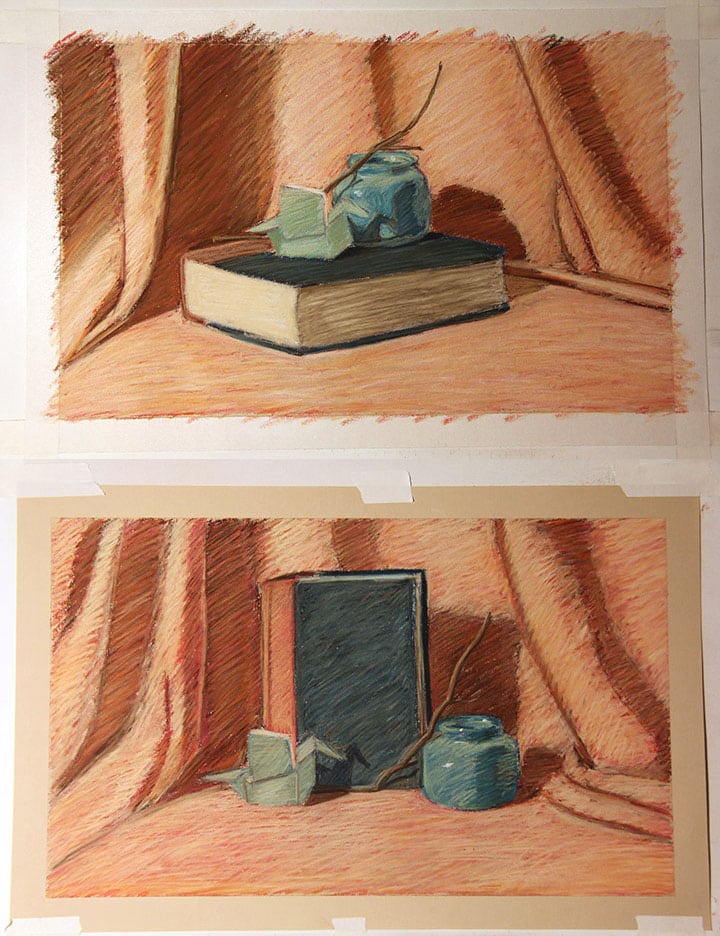ILL 121: Drawing II
Master the medium as you take your drawing to the next level
You can learn to observe the world around you and draw it. In this intermediate drawing course for illustration majors, you will build on your foundation drawing skills through a wide ranging series of classical studies. You will explore the application of concepts like value, additive and subtractive mixing, and depth of field, learning how to handle different mediums like graphite, charcoal, and pastel, and tackle challenges like textures, highlights, and reflections. With an emphasis on the mixing, blending and combining color, the course will prepare you for your next level painting and drawing projects.
About This Course
Project-Based Learning
Creative projects range from still life studies to explorations of value, capturing light effects, depth of field, atmosphere, working from source material, and combining and mixing color.
What Skills Will I Develop?
Students in this course can expect to learn to:
What Software and Supplies Do I Need?
- Computer with Internet connection.
- Intermediate drawing materials such as graphite pencil, paper, charcoal, chalk pastel, chamois, and easel. More detailed information on supplies available at course syllabus page.
- Access to a digital camera for photographing your artwork.
Course Instructor(s)
The course is taught by the following instructor(s):

Jordon Schranz is an audio/visual artist and designer whose work has been exhibited internationally in New York, Chicago, El Paso, Berlin, Bogotá, and Ciudad Juárez.
Course Outline
Planar Approaches
For this course, you may need to expand your art supplies, so we'll begin our course with an overview of the supplies you'll need in this course. The first lecture will explore the concept of how depict the value on planar surfaces. We will outline a planar approach to value. Our first drawings will be created in graphite, so we will explore physical tips for applying marks and using hatching/crosshatching as value techniques.
Additive and Subtractive Value
Certain kinds of media require understanding additive and subtractive approaches to creating a range of value in our drawings. This week we will focus on how to use charcoal as a material, including the use of pencils, vine/willow sticks, and additive/subtractive techniques. We'll also explore how to draw drapery, a classic subject for understanding value, looking at types of folds and tips for our first drapery study drawing.
Highlights, Reflections, and Transparent Objects
Some subjects present challenges when we try to draw them. Objects with
highlights, reflections, or transparency can be a real hassle. This week we will explore some media—gray-tone Canson paper, white charcoal pencil, and compressed charcoal—and some techniques that will help us get to grips with these common light effects.Creating Depth and Atmosphere
What's the focus in your drawing? Artists use techniques like depth of field, contrast focus, and various atmospheric effects to draw the eye to the subject in a drawing, as well as to enhance its mood and message. This week we will explore classic techniques like Tenebrism and Sfumato to see what we can learn and apply in our drawing. We will also study a production technique for working from a source image and keeping each part in proportion.
Color, Value, and Blending
To connect your drawing to the world that you see, and to the world of painting, we will explore drawing with color this week. We will review how color works, breaking it down into hue, saturation, and value (or brightness) and exploring the difference between chromatic, achromatic, and monochromatic uses of color. To learn how artists have used value to achieve color, we will discuss the "extreme" color use of the Fauvist artists. We will examine how to use the charcoal medium and use optical blending to mix color.
The Perception of Color
In the final week of this course we will expand your concept of color, discussing the mixing and blending of color, and how to use CMY and RYB color wheels. We'll discuss how to compose with color using analogous and complementary color schemes, hot/cool properties of color. Finally we will explore how to use chalk pastels and discuss strategies for mixing colors in your drawings, such as avoiding reliance on local color, mixing with analogous hues, and more.
Frequently Asked Questions (FAQ)
How Do The Courses Work?
Our courses are project-based and instructor-led. In each course you’ll complete a series of lectures, projects, discussions, and critiques designed to stretch your creative skills. Weekly assignment deadlines keep you on track, and with no set-logins or Zoom meetings, you can build your studies around your schedule.
Who Are The Instructors?
Our courses are developed and taught by our industry-leading faculty of creative professionals. This means that you’ll learn in-demand skills, get feedback on your work, and build a portfolio of creative work. View our Student Gallery for featured student projects.
When Can I Start?
Classes start January, April, and August, and this course is completed in a 15-week term. College credit from this course can be applied to a range of Degree and Certificate programs at Sessions College. You can enroll in this course on an individual basis or as part of a program.
Explore our Programs: Bachelor's Degree | Associate Degree | Undergraduate Certificate
How Do I Register?
To register for a program, complete our program application. To register for this course on an individual basis, please contact our admissions team at admissions@sessions.edu. An Admissions Advisor will contact you to setup your enrollment.
| Course Tuition and Fees | |
|---|---|
| Tuition | $350/credit |
| Registration Fee* | $200 |
| Total Course Price | $1250 |
Registration fees are nonrefundable after 5 days from enrollment.
Is Sessions College Accredited?
Yes. Since 2001, Sessions College has been accredited by the Distance Education Accrediting Commission (DEAC). The Distance Education Accrediting Commission is listed by the U.S. Department of Education as a recognized accrediting agency and is recognized by the Council for Higher Education Accreditation (CHEA).
RELATED PROGRAMS AT SESSIONS COLLEGE:


